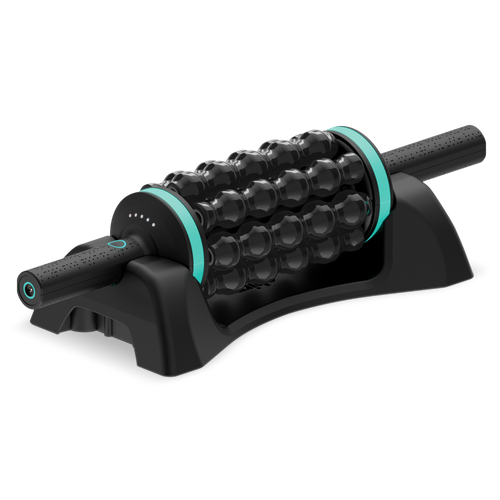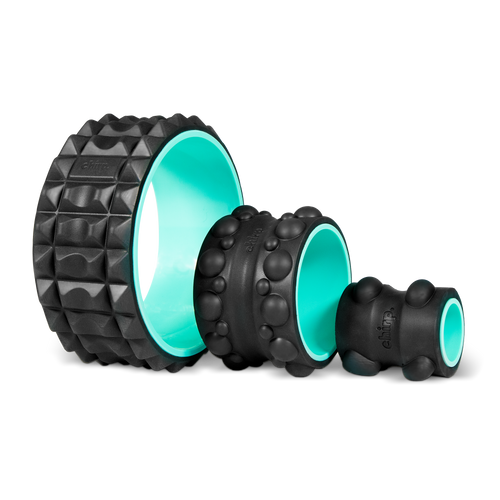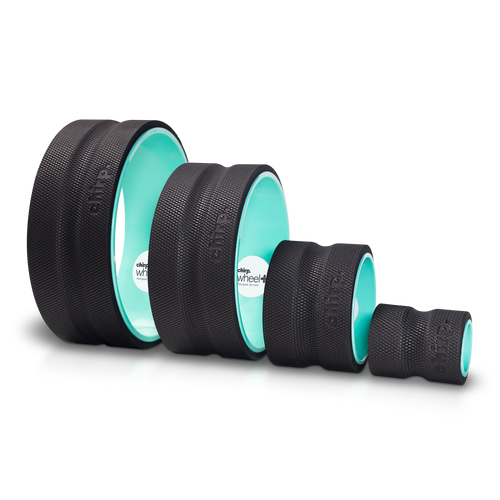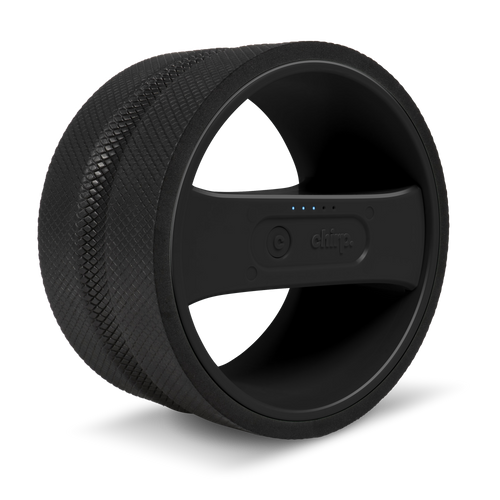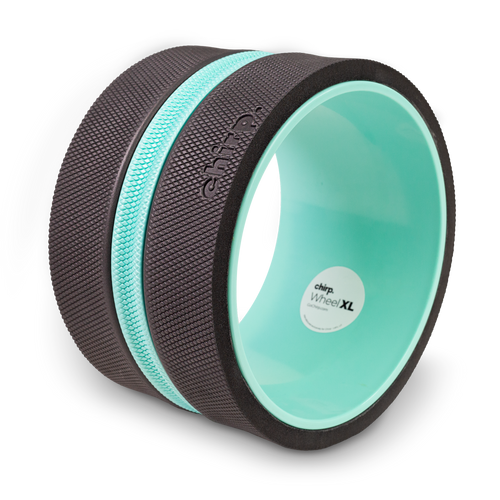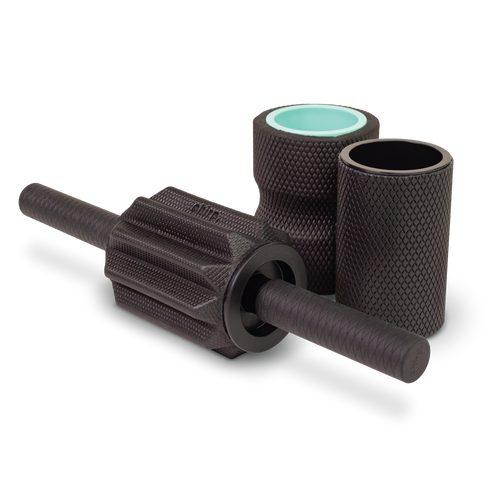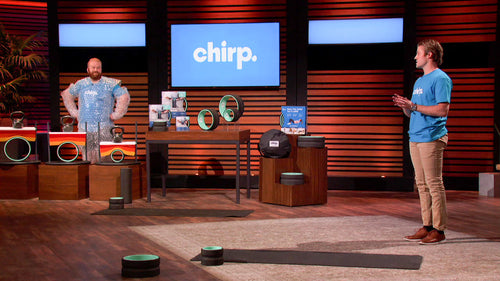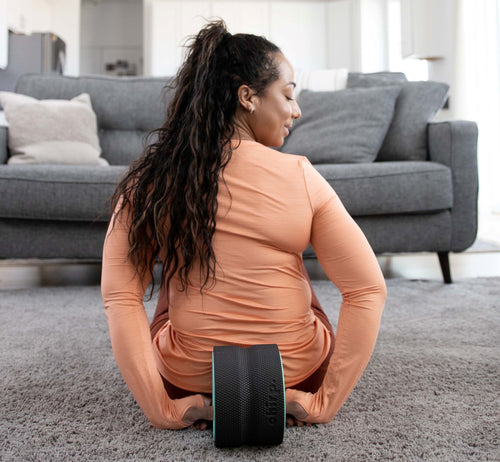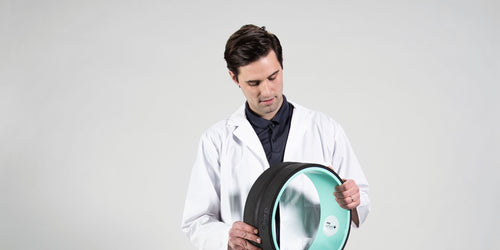What is the Chirp Wheel+?
The Chirp Wheel+ is a back roller that stretches the muscles around your spine to relieve upper back pain, lower back pain, neck pain, and hip pain. It is shaped like a wheel so it can fit between your shoulder blades and massage deeply into the muscles around your spine. It comes in three different sizes: Gentle (12 inch), Medium (10 inch), and Deep Tissue (6 inch). The main difference between each wheel is diameter; the smallest wheel applies the most pressure, and the largest wheel applies the least amount of pressure.
To find out more about why the Chirp Wheel+ is good for your back, read this blog post.
Basic Stretches on the Chirp Wheel+
You can do the following stretch with any three of the wheels:
How to Roll Out on the Chirp Wheel+
1. Sit on the ground with your knees bent and feet firmly on the ground. Place the Chirp Wheel+ against your back and while holding onto the wheel, gently lie back. Relax. Stay in this position until you feel ready to move on.

2. Rest your upper back on top of the wheel with it between your shoulder blades. Still holding onto the wheel for support or resting your hands on the ground for balance, raise your glutes off the floor. Relax. Stay in this position until you feel ready to move on.

3. Begin to roll back and forth on the wheel by bending and straightening your legs and walking yourself forwards and backwards. It will be a forward-backward motion.

4. For a deeper stretch, lower the back of your head towards the ground and drop your arms to the floor. Relax. Roll out on the wheel for 5 to 10 minutes.

5. If it is difficult for you to sit on the ground or if using the wheels on the ground is too much pressure, you can use the wheel against the wall for less pressure and easier maneuvering.

How to Utilize the Deep Tissue Chirp Wheel+
You can also use the Deep Tissue Chirp Wheel+ as a posture corrector or like a foam roller on your hips and legs.
1. The Deep Tissue Chirp Wheel+ is small enough to fit in the small of your back when you’re sitting down. Sitting with the wheel between you and your chair will help you sit up straight by reinforcing the natural curvature in your spine while pushing your shoulders back.

2. To use the Deep Tissue Chirp Wheel+ on your legs and hips, simply sit on the floor and place the wheel under the part of your body, such as your thigh, that is tight and massage it with the wheel. Roll your body back and forth over the wheel.
Bonus Stretches with the Chirp Wheel+
The following stretches are focused on the shoulders and upper back:
Chirp Wheel+ Shoulder Stretch

- Start on your hands and knees with the Chirp Wheel+ in front of you.
- Put your palms together and place your hands on the top of the wheel.
- Gently roll the wheel forward with your hands. You will feel a stretch in your shoulders and chest.
This stretch can help you reverse any damage done from poor posture and can help relieve upper back and shoulder pain (Pinkham, 2016). This is a great stretch to do even before you roll out on the wheel. This stretch opens up a tight upper body and is great for those who sit a lot or who have poor posture.
Chest Opener

- When preparing to roll out on the wheel, instead of keeping your hands on the wheel or at your sides, try putting them behind your head.
- Lie back over the wheel, resting your head back as far as is comfortable.
- Relax.
This is a good starting position stretch to open up shoulders. You can also extend one arm at a time. This stretch helps to reverse damage from poor posture.
Chirp Wheel+ Airplane

- While rolling out on the wheel, instead of keeping your hands on the ground or on the wheel, try opening your arms up like an airplane.
- Relax.
This stretch allows gravity to open up the chest and shoulder area and even stretches biceps.
Back Bend with the Chirp Wheel+

- While rolling out on the wheel, extend your arms up over your head and touch the ground, letting your head fall back.
- If you’re really ambitious, you can pull your hands under your head and lift into a backbend from here. The wheel makes it easier to go into and out of a backbend because you can just come right back down onto the wheel.
This stretches and opens up the upper and lower back, depending on the placement of the wheel. It is a great stretch for improving flexibility.
Side Stretch with the Chirp Wheel+

- Sit next to the wheel, then gently roll your side onto the wheel.
- Extend your arms and legs, keeping your feet and hands on the ground for balance.
- Let your body relax to the floor.
- Do this on both sides.
If you need to stretch out your arms or sides after a workout, the wheel is a great tool to use for a deeper stretch. Let your body relax over the wheel like a rag doll for the best results.
Staff Pose with the Chirp Wheel+

- Roll on the wheel like normal. Stop the wheel when it is between your shoulder blades.
- With your knees still bent, bend you arms up over your head as you roll the top of your head onto the ground. Hold onto the wheel with your hands. Your elbows should touch the ground.
- Your legs should now be straight from rolling backwards so your head touches the ground.
This is a great stretch for the upper back, arms, and even the tops of the legs. It can also strengthen your core muscles while deeply opening up your chest and correcting poor posture.
Deeper Shoulder Stretch

- Roll out on the wheel like normal, but lift your hands up then bend your arms to hold onto the wheel.
- Dip your glutes down close to the ground, holding onto the wheel.
This will strengthen your core and leg muscles and open your shoulders and chest.
The following stretches are focused on the lower back, hips, and legs:
Child’s Pose with the Chirp Wheel+

- To begin, get on your hands and knees.
- Bend your knees to put your butt to the heels of your feet, and reach your hands forward.
- For the regular pose, let your hands rest on the ground. If you want a deeper stretch, let your hands rest on the top of the Chirp Wheel+.
- Let your body sink into the ground.
If your lower back is tight, you will feel a stretch in the muscles that need it the most. This pose also helps relieve tension in your back, shoulders, and neck.
Lower Back and Shoulder Release

- Sit on the ground with the Chirp Wheel+ in front of you.
- Put your feet together in the butterfly position. Put your palms together, and place your hands on the wheel.
- As you push the wheel forward, let your head hang down between your arms. This will help stretch your lower back, shoulders, and legs. You can even pulse, gently rocking forwards and backwards, to help yourself get a deeper stretch.
This is a good stretch if you are not very flexible in your hips or lower back (Yoga Wheel Flow, 2018). Doing this without the Chirp Wheel+ makes it harder and less comfortable to lean forward, but the wheel can help ease you deeper and deeper into your stretch, opening up your hips and stretching your lower back.
Seated Forward Bend


- Sit on the ground with your legs straight in front of you.
- Bend forward at the hips while reaching your hands in front of you to touch your toes.
- Relax your head by tucking your chin to your chest.
- If you need a deeper stretch, place the Chirp Wheel+ (any size) under your ankles.
This stretch loosens the muscles around your spine (especially your lower back), shoulders, and hamstrings.
Butterfly Pose

- Sit with the bottoms of your feet together and your knees open wide.
- Lie back onto the ground, letting your knees fall toward the ground.
- For a deeper stretch, place the Chirp Wheel+ in the small of your back, stretching your back over the wheel. Let your head relax backwards so you can stretch your neck muscles as well.
This helps relax and open your hips, which makes it a great stretch for those who sit all day.
Bent Knee Recline

- Kneel down with the Chirp Wheel+ behind you.
- Gently lean back into the wheel. Lift your arms up and back, letting your head fall back until you feel a nice stretch.
- Relax.
This stretch creates an even deeper hip opening effect than the butterfly pose. It helps open up everything from your arms to your quads.
Lower Back Stretch


- Start by rolling out on the wheel like normal.
- While holding onto the wheel, gently let your shoulders and head touch the ground.
- Doing this will likely bring your feet off the ground if you aren’t super flexible. You can lift your feet off the ground for less of a stretch or leave your feet on the ground for a deeper stretch.
This will stretch out your lower back and can be a small ab workout.
Knee Lifts with the Chirp Wheel+


- Start your knee lifts by gently rolling out your back muscles with the Chirp Wheel+. Once you feel like your back muscles are loose, stop the wheel in the arch of your back.
- Let your head rest back on the floor (use a Deep Tissue Chirp Wheel+ or a pillow if necessary), and straighten your legs. Rest in this position for a moment.
- Keep your hands on the ground to keep your balance. Engage your core muscles as you bend your knee toward your chest. Then let your leg gently rest back down. Do this with both legs.
- To make this exercise easier, bend your knees at a 90 degree angle and then lift your knee toward your chest. If you have good balance, you can also lift your knee up with your hands.
This stretch will simultaneously stretch the front of your straight leg and buttocks muscles and lower back muscles of your bent leg. Alternate legs for an even stretch on both sides of your lower back.
References:
365 Fitness & Beauty. (2017, May 25). Yoga Wheel: An Ultimate Guide For Beginners (Updated). Retrieved from https://365fitnessbeauty.com/yoga-wheel-guide-beginners/.
@mommayogini_83. (n.d.). Yoga Wheel Stretches/Poses. Retrieved from https://www.pinterest.com/pin/203999058098297824/.
Kassandra. (1970, January 1). How To Use A Yoga Wheel. Retrieved from https://blog.yogawithkassandra.com/2015/12/how-to-use-dharma-yoga-wheel.html.
Pinkham, H. (2016, September 8). How to Use a Yoga Wheel. Retrieved from https://www.youtube.com/watch?v=Qe3yh9LkNtk.
Yoga Wheel Flow: Total Body Workout. (2018, December 6). Retrieved from https://www.thejourneyjunkie.com/yoga-videos/yoga-wheel-flow-total-body-workout-video/.
